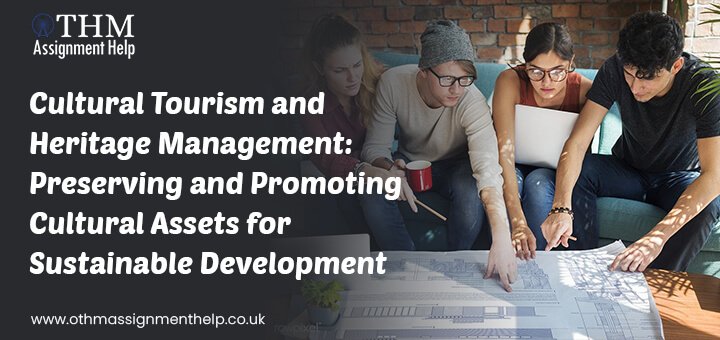Cultural tourism and heritage management assume crucial roles in preserving and advancing the rich cultural heritage of countries while contributing to sustainable development. As travelers increasingly look for bona fide and immersive experiences, the social travel industry has emerged as a strong driver of economic growth, community strengthening, and social preservation. In this guest post, we delve into the meaning of social tourism and heritage management, investigating their effect on supportable development and the best practices for utilizing cultural assets effectively.
Understanding Cultural Tourism and Heritage Management
Cultural Tourism:
Cultural tourism includes heading out to encounter the way of life, culture, heritage, and lifestyle of the neighborhood communities. It envelops visits to authentic destinations, galleries, celebrations, indigenous communities, and native communities, OTHM Assignment Writing Services< offers explorers valuable chances to immerse themselves in the neighborhood culture and interact with its people.
Heritage Management:
Heritage management incorporates the safeguarding, preservation, and understanding of cultural and regular heritage locales, artifacts, and customs. It includes the insurance of unmistakable and intangible cultural resources, like monuments, archeological locales, conventional specialties, rituals, languages, and oral histories, to safeguard them for people in the future.
The Importance of Cultural Tourism and Heritage Management
Preservation of Cultural Identity:
Cultural tourism and heritage management assume crucial roles in preserving the cultural character and heritage of communities, encouraging a deep satisfaction, having a place, and coherence among local residents.
Promotion of Sustainable Tourism:
Cultural tourism and heritage management advance economic tourism practices that limit ecological effects, safeguard social authenticity, and advantage neighborhood communities. By taking on practical travel industry standards, objections can protect regular resources, lessen fossil carbon emissions.
Sustainable Tourism and Environmental Protection
Sustainable tourism’s motivation is to oversee tourism and tourism growth in a mindful manner, for example, not causing natural harm, environmental change, contamination, loss of biological systems, and keeping the consumption of resources at unsustainable levels.
Working with Local Communities
Empowering local communities and having them required as a key partner is, in many cases, respected by UNESCO, for example, as a way that can yield concrete results. Getting sources of information and feedback from individuals living around touristic destinations about continuous or future projects, is a method for engaging the neighborhood populace. The thought is to set out opportunities for local businesses by finding ways, whenever the situation allows, to accommodate their specific necessities and the objective’s drawn out supportable development.
Educating and Empowering the Visitors
To influence the visitors’ behavior in a positive manner, the heritage manager can fabricate the visitors experience around education.
Frequently seen as a danger to the preservation of cultural and natural destinations, sightseers’ presence can be put to use for protecting a site. This monitoring project has been striving for the preservation of the Great Barrier Reef off the shore of Australia. It not only brings to light the reef’s untamed life insurance, but additionally empowers tourists to gather and report data about the reef’s health.
Visitor Management
Visitor management guarantees that visitors to the objective—now and later on—can encounter unspoiled and carefully conceived attractions at well-preserved heritage sites. Being aware of individuals that might be interested at any point without risking physical damage is foremost. Visitor management in this situation implies overseeing visitor flow, or even, restricting admittance to the site to a specific number of individuals at a given time.
Best Practices in Cultural Tourism and Heritage Management
Community Engagement and Empowerment:
Engaging local communities in dynamic cycles and engaging them to effectively partake in cultural tourism and heritage management drives is fundamental to guaranteeing their ownership and sustainability. By including local area individuals in planning, implementation, and advantage sharing, objections can cultivate comprehensive and fair development that regards and preserves local societies and customs.
Implement a Management plan:
A management plan is a document that frames the vision, targets, methodologies, and activities for the preservation and promotion of a heritage site. It ought to be founded on the aftereffects of the effect assessment and the standards of responsible tourism. A management plan ought to likewise be participatory, including the cooperation and consultation of the stakeholders who have an interest in or a role in the site. A management plan ought to be consistently checked, evaluated, and refreshed, to guarantee its effectiveness and significance. A management plan ought to likewise be lined up with the public and international policies and principles for heritage insurance and tourism development.
Education and Interpretation:
Education and interpretation programs assume a significant role in upgrading guests’ comprehension and enthusiasm for cultural heritage sites and customs. Interpretive signage, guided tours, intuitive displays, and educational workshops give setting, importance, and significance to social encounters, improving visitors’ movement encounters and cultivating a more profound connection with the objective.
Conclusion
Cultural tourism and heritage management are basic to preserving and advancing social assets for feasible development. By celebrating social variety, encouraging economic opportunities, and enabling neighborhood networks, cultural tourism drives can add to the social, economic, and environmental prosperity of objections all over the planet. Through dependable stewardship, cooperative partnerships, and local area commitment, we can guarantee that social legacy stays a wellspring of motivation, pride, and prosperity for a long time into the future.



